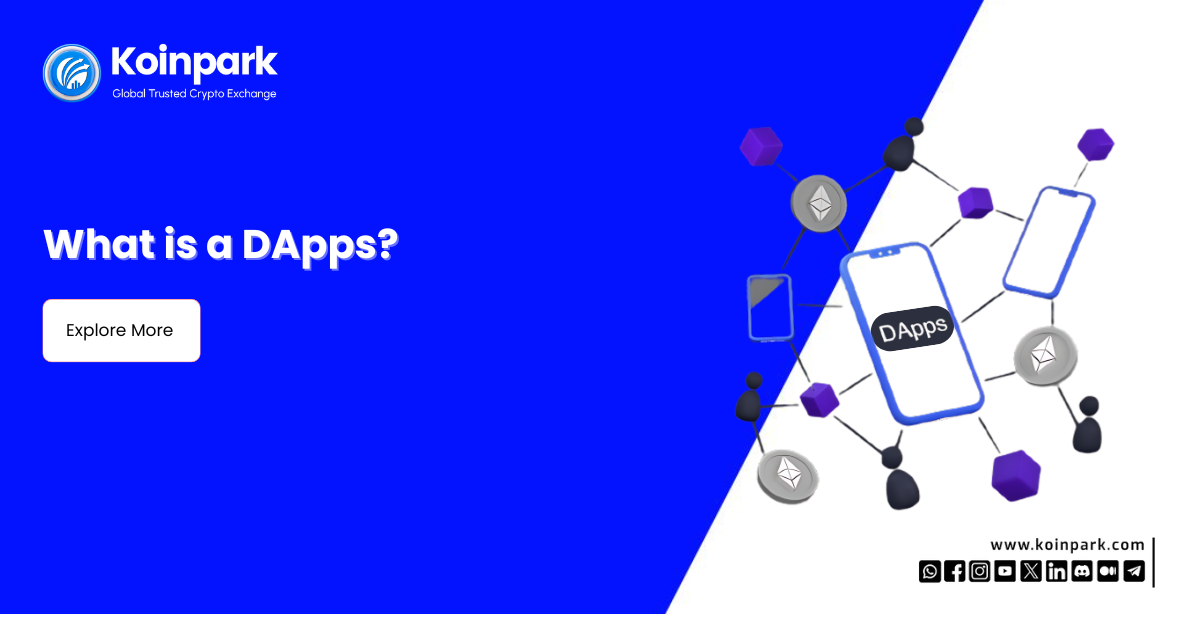Introduction to dApps
Imagine your phone, filled with various applications like Facebook, Instagram, Gmail, and YouTube. These apps run code created by their respective companies, allowing you to interact with their services.
A decentralized application, or dApp, operates similarly but instead of communicating with centralized servers like Facebook or TikTok, it interacts with the blockchain. Through these apps, you engage directly with the blockchain.
In this article, we’ll dive into what dApps are, how they work, and why they could be pivotal for the future of technology.
We’ll explore the benefits of dApps and look at different types, including several specific examples.
Benefits of dApps
Built on Smart Contract Networks
The first thing to know is that dApps can only be created on smart contract networks. This means blockchains like Bitcoin, which are designed solely for sending their native coin, cannot support dApps.
However, Ethereum can, thanks to its smart contracts. In simple terms, smart contracts are code-based agreements between two parties that don’t require a third party’s trust — just the code itself.
Open Source Code
Another significant benefit is that the dApp code is open source. This means anyone can view and verify the code, fostering greater trust.
Unlike centralized applications like Facebook, where you can’t see how friend recommendations work or how Google knows your preferences, dApp code is transparent and inspectable.
Censorship Resistance
dApps are also censorship-resistant, meaning they don’t answer to governments, corporations, or individuals. Once a smart contract is triggered, it runs as code, and no one can stop it.
This is crucial for financial applications, ensuring that no one can control your money. Historically, governments have misused control over citizens’ money, and social media platforms like Facebook and Twitter have censored users based on their views.
Decentralized applications prevent such control unless specifically coded to do so.
Always Online
A key benefit of dApps is their ability to stay online continuously. While platforms like Facebook or YouTube can experience downtime due to server issues or government interference, dApps run on a blockchain supported by countless computers worldwide.
Shutting down all these computers is nearly impossible, ensuring the dApp remains operational.
Types of dApps
Defi Financial dApps
1. Borrowing and Lending
Aave is a platform where users can deposit Ethereum or Matic tokens into smart contracts and earn interest.
Users can also borrow tokens if they have enough collateral deposited, enabling different borrowing and lending strategies. Learning about such platforms can be crucial for those using a Global Cryptocurrency Exchange.
2. Providing Liquidity
Providing liquidity is complex, but simply put, investors can buy tokens and invest them in liquidity pools.
These pools facilitate trading, and traders pay fees that provide returns to the investors.
3. Exchanges
Decentralized exchanges, or DEXs, allow users to trade tokens quickly and with low fees, without needing background checks or identification verification.
This means you can trade large amounts of Ethereum without scrutiny. For newcomers wondering How to buy Bitcoin, understanding DEXs is essential, as they offer one of the best ways to buy crypto.
Game dApps
1. CryptoKitties
CryptoKitties allows users to buy, collect, and breed virtual kittens, represented by NFTs. Older-generation kittens are often more valuable, and players can profit from selling or renting out their kittens.
2. Zed Run
Zed Run is a gambling app where users buy NFT horses and race them. Each horse has unique skills, and all races are recorded on the blockchain. The game combines gambling’s appeal with blockchain technology.
3. Gambling dApps
There are numerous blockchain gambling dApps offering games like poker, slots, roulette, dice rolling, and coin tossing. These can be coded so the house always wins, attracting many players.
Tracking Apps
ZapperFi
ZapperFi collects information from wallets and displays it on a single dashboard. It shows assets from various dApps and networks, providing a comprehensive view of your blockchain portfolio.
Understanding such tools can be beneficial for managing assets like BTC to INR or USDT to INR conversions.
Marketplaces
1. CryptoKitties
Apart from being a game, CryptoKitties is also a marketplace where users can buy and sell NFT kittens, paving the way for the mass adoption of digital assets.
2. Rarible
Rarible is a marketplace for NFTs where users can buy, sell, and create NFT art. It facilitates blockchain interactions, making it user-friendly for everyday people. Platforms like Rarible are integral when considering a Token Listing.
3. Bidali
Bidali allows users to buy goods with cryptocurrency, including gift cards that can be delivered anonymously. While users must report these transactions for tax purposes, Bidali itself doesn’t report to tax authorities.
ENS: A Unique dApp
The Ethereum Name Service (ENS) doesn’t fit neatly into the above categories. It allows users to register human-readable names for Ethereum addresses, simplifying blockchain interactions.
For those new to crypto and wondering How to buy your first Bitcoin, understanding ENS can simplify transactions.
By understanding dApps and their diverse applications, you can see how they are shaping the future of technology.
Conclusion
Decentralized applications (dApps) are revolutionizing how we interact with technology by leveraging blockchain for transparency, censorship resistance, and continuous availability.
They offer innovative solutions across finance, gaming, tracking, and marketplaces.
Understanding dApps is essential for those exploring cryptocurrencies, managing BTC to INR or USDT to INR conversions, or learning how to buy Bitcoin in India.
Platforms like Aave and Rarible showcase the potential of dApps in transforming finance and digital asset exchanges.
As technology evolves, dApps will continue to lead the shift towards decentralization, promising a future where decentralized solutions become mainstream. Stay informed and embrace the potential of dApps to fully harness their capabilities.





Comments